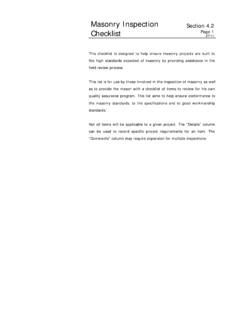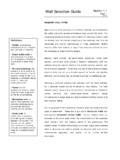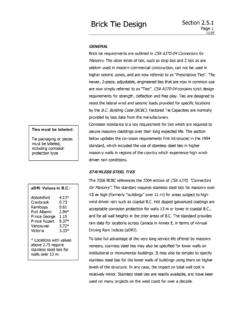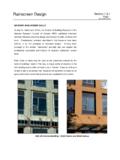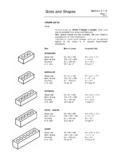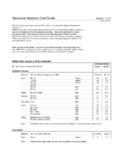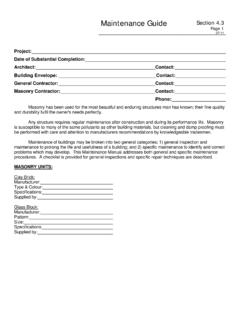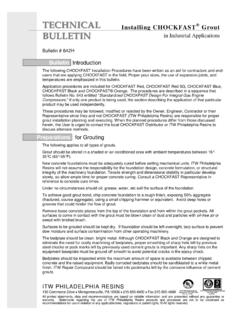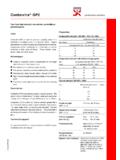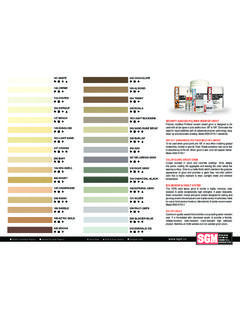Transcription of Grout and Reinforcing Section 2.3 - masonrybc.org
1 Grout & Reinforcing Section Page 1 07/11 Grout , or block-fill as it is sometimes referred to, is specified to CSA A179-04. TYPES OF Grout Coarse Grout , the most commonly used type of Grout , has a maximum aggregate size of 12 mm (1/2 ). The slump should be between 200 and 250mm (8 -10 ). This is much higher than typical ready mix concrete, but is very necessary to properly fill the cores of masonry units and flow around reinforcement or other elements within the wall. Fine Grout uses coarse sand for aggregate and would only be used in small core units such as reinforced brick. Fine Grout is required to flow through small openings so a Grout slump of over 250mm is recommended. Grout is usually supplied in ready-mix trucks, with quality control data available from the supplier. Field test cylinders may also be taken. Grout STRENGTH Grout strength specification is a topic requiring clarification.
2 Because Grout must flow for substantial distances through small core openings, it must be placed at a very high slump of 200 to 250 mm. After placing, the water required to increase the slump is then absorbed into the units to provide a concrete mix with a normal water content - and higher final strength. Grout tested using standard non-absorptive plastic or metal cylinders still contains the extra water, and develops correspondingly lower strength results. The Pinwheel test simulates the absorption conditions the Grout would experience in the wall, but is awkward to use on site and is seldom used. Typical test results for the same Grout mix: Pinwheel test: 18 to 25 MPa Cylinder test: 13 MPa Pinwheel used to test Grout Section Page 2 07/11 Grout & Reinforcing CSA A179 recognizes this difference in sample preparation by calling for only a MPa Grout strength when cylinders are used. The actual strength in the wall will be much higher, typically over 20 MPa which exceeds the 15 MPa strength of standard concrete blocks.
3 This Grout strength is compatible with the design strengths contained in CSA However, Structural Notes and specs have typically called for 20 or 25 MPa Grout tested by cylinders. In reality, a 20 MPa Grout may be preferred for pumping reasons anyway. If Structural Notes do not recognize the MPa strength minimum, then a project cylinder test result below a 20 or 25 MPa specified strength should not treated as a cause for concern. A 25 MPa high slump Grout designed for cylinder testing may actually be 40 MPa in the wall. This is a waste of money (extra cement) and may be a less satisfactory product (compatibility and shrinkage). (Also see Section Guide Structural Notes) Sample spec: Grout to CSA A179-04 Minimum compressive strength MPa at 28 days by cylinder test under the property specification Maximum aggregate size 12 mm diameter Grout slump 200 to 250 mm CLEANOUT / INSPECTION HOLES Unit cores that are to be grouted should be free of excessive mortar protrusions and mortar droppings at the base.
4 Clean-out/inspection holes at the base of the reinforced cores will facilitate the removal of excessive mortar droppings, and confirm that Grout has reached the bottom of the core. Clause of CSA A371-04 Masonry Construction allows the requirement for clean-out/inspection holes to be waived by the designer when the contractor has demonstrated acceptable performance or where the walls are not structurally critical. In some cases the designer will require the initial walls to have clean-outs pending demonstrated performance, and then waive cleanouts for the remaining walls. Grout & Reinforcing Section Page 3 07/11 GROUTING While grouting, care must be taken to completely fill the reinforced cores and to ensure that all bars, bolts and anchors are fully embedded. Grout is typically pumped in (8 ) pours from bondbeam to bondbeam. The maximum pour height in CSA A371-04 is m, but this would only be practical for H-block or 250 or 300 mm units.
5 For a Grout pour of 3 m or more, the Grout must be placed in lifts of 2 m or less. (For more detail, see Section - Guide Structural Notes) REINFORCEMENT See Section for minimum reinforcement requirements. The core size of the masonry units will dictate the size and number of bars that can be effectively grouted. Typically, reinforced masonry makes use of 15M or 20M bars. Units 125, 150 and 200mm wide should not contain more than one vertical bar per core. Units 125 and 150mm wide should be restricted to one horizontal bar per course in bondbeams. (See also Section - Guide Structural Notes) NOTE: At splices, the number of bars per core is doubled increasing congestion. Maximum number of bars 100 mm 125mm 150mm 200mm 250mm 300mm Vertical bars per core N/A 1 1 1 2 2 Horizontal bars per course (lintel, bondbeam) N/A 1 1 2 * 2 * 2 * * 2 bars in bond beam can help to center vertical steel Reminder: for every bar specified, there are two at splices.
6 2 bars vertically and 2 bars horizontally in a 20cm wall are almost impossible to Grout , particularly at splices where steel is doubled. Grout Lift: that portion of a total Grout pour placed in one pass of the Grout filling process. Grout Pour: the total height of Grout placed in a wall during a grouting operation. A Grout pour consists of one or more Grout lifts. Section Page 4 07/11 Grout & Reinforcing JOINT REINFORCEMENT Joint reinforcement is used in addition to horizontal steel bars when bondbeams are spaced at more than 1200 mm. It is a ladder of 9 gauge ( mm) wire installed in the mortar joint, which positions a wire in the centre of each block faceshell. It is spaced at a maximum of 600mm, 400 mm for stack pattern, and at 400 mm in seismic zones. Joint reinforcement resists wall cracking and can contribute to the horizontal steel area in the wall.
